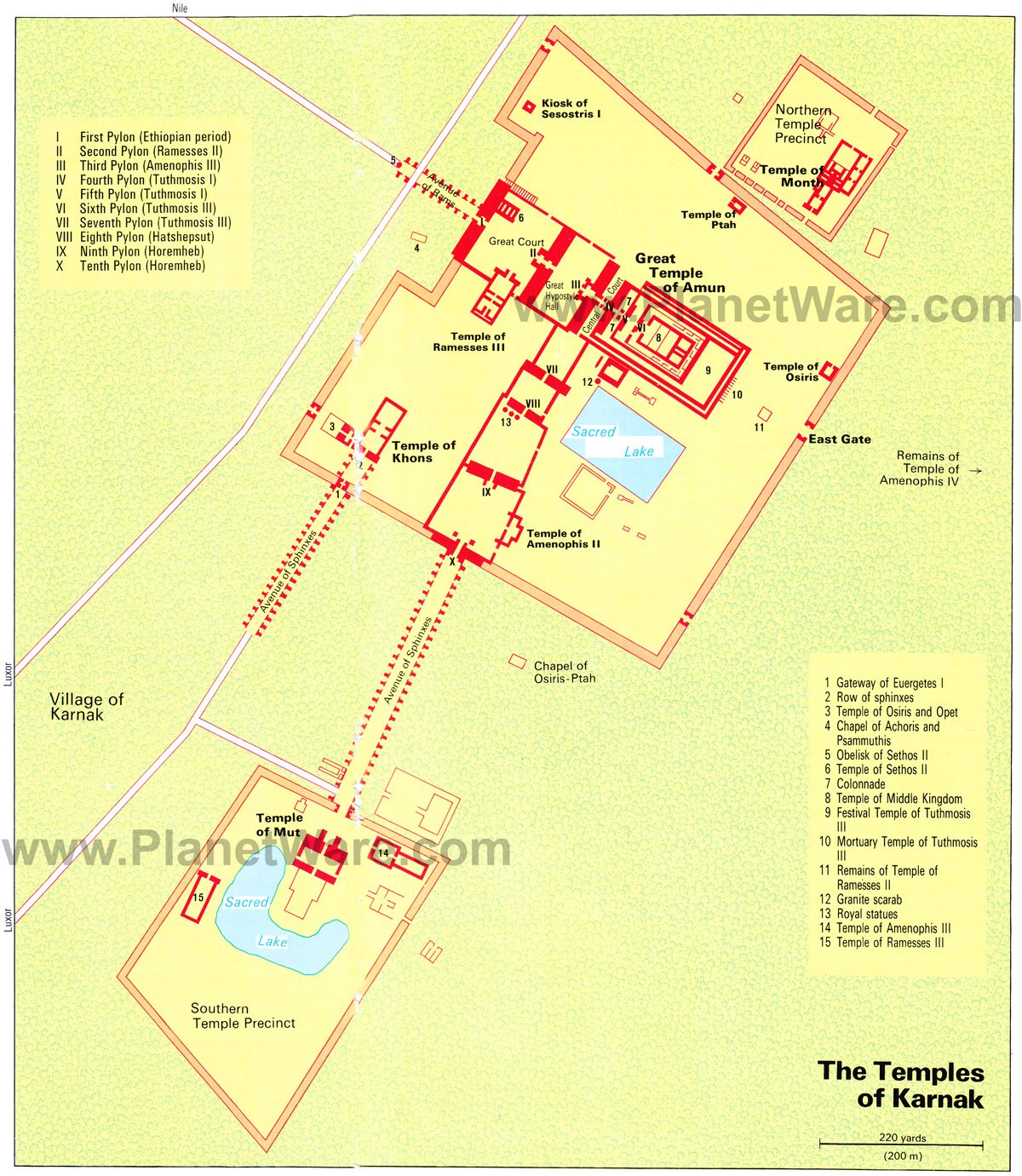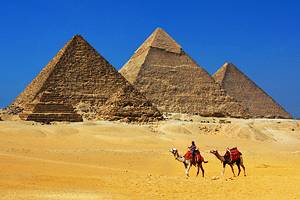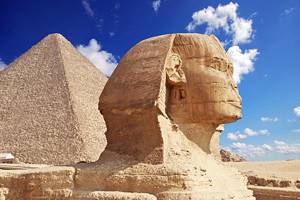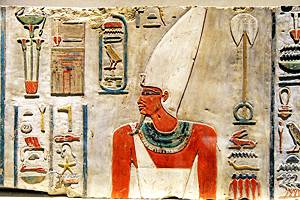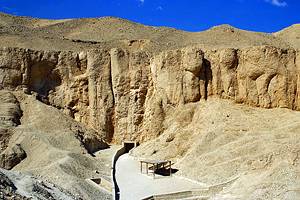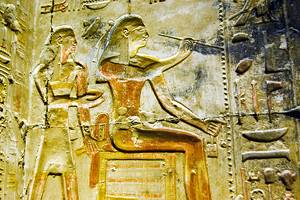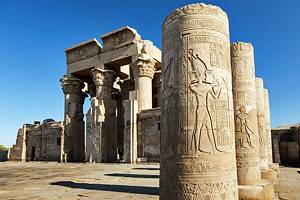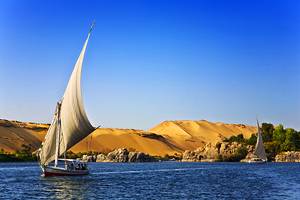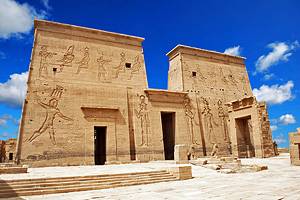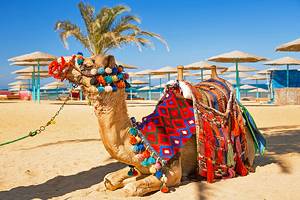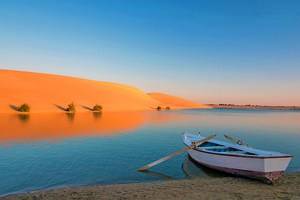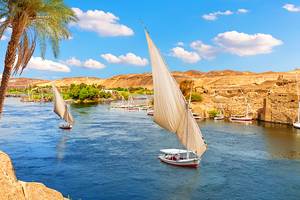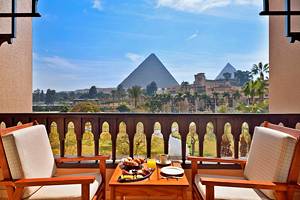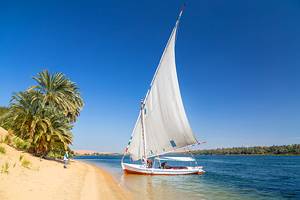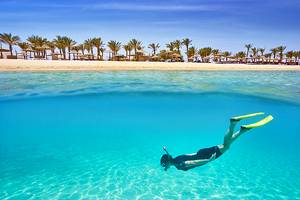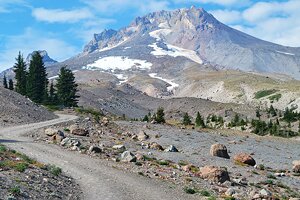Exploring the Temples of Karnak: A Visitor's Guide
Big, bold, and hugely ambitious, Luxor's mammoth Temple of Karnak complex is one of Ancient Egypt's grandest building projects.
Every pharaoh worth their salt added and amended the buildings here during their reign, stamping their seal on the kingdom's most revered religious sanctuary. For Karnak was the house of the gods, and its glories were to be feted by all.
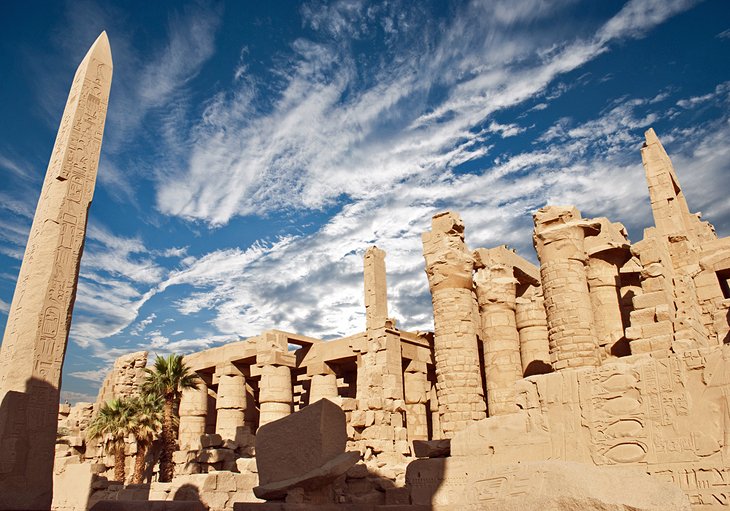
Although sacked by the Assyrian and Persian armies and looted and pilfered by early explorers and travelers, who carted off statues and masonry, there are few other temple complexes in the world that are still so commanding and majestic today. The Pharaonic kingdoms may be long gone, but their power lives on in this triumphant testament of stone.
If you're short of time, the Great Temple of Amun is the main building and should be your key destination, but plenty of scattered temple remnants (in various ruinous states) surround it.
Use our visitor's guide to exploring the Temples of Karnak to help you navigate and understand this vast complex on your visit.
On This Page:
- Avenue of Sphinxes
- Great Temple of Amun
- Kiosk of Sesostris
- Temple of Ptah
- Northern Temple Precinct
- Temple of Montu
- Temple of Ramses II
- Temple of Osiris
- East Gate
- Sacred Lake
- Temple of Khonsu
- Temple of Osiris and Opet
- Southern Temple Precinct
- Temple of Mut
- Tips and Tactics: How to Make the Most of Your Visit to the Temples of Karnak
- Getting to the Temples of Karnak
Avenue of Sphinxes
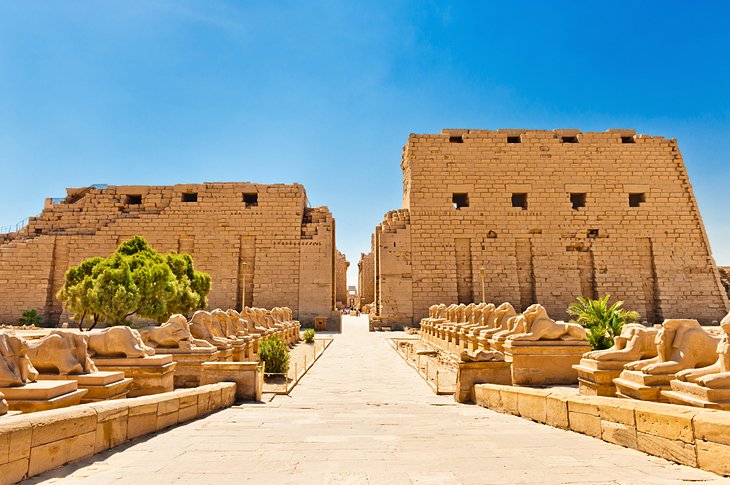
You enter the complex through a grand processional way, flanked on both sides by ram-headed sphinxes.
These once ran all the way to Karnak from Luxor Temple (in downtown modern Luxor), as the triumphant three-kilometer-long thoroughfare connecting the two temples. During the Ancient Egyptian annual Festival of Opet, the statues of Amun, Mut, and Khonsu were paraded out of Karnak, down this avenue to Luxor Temple.
In recent years, excavation work in downtown Luxor has uncovered large sections of this original processional way, though the section leading to the entrance to the Karnak complex remains the most impressive.
Great Temple of Amun
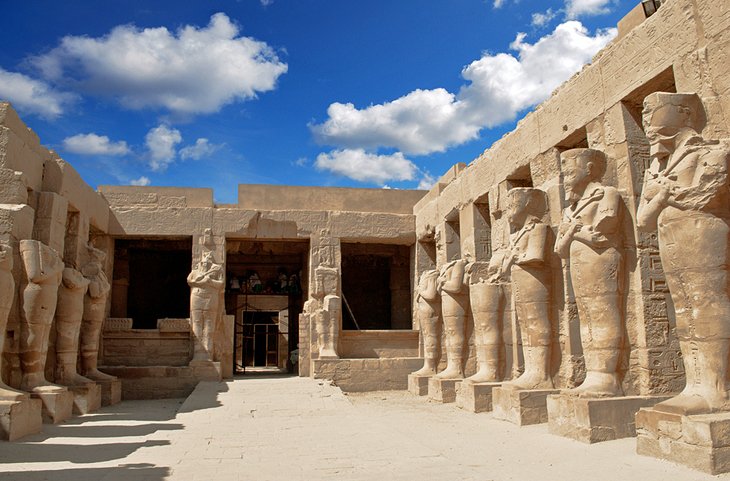
The Great Temple of Amun is Karnak's main temple building, and like nearly all of Egypt's surviving monuments, the temple has seen additions and improvements by the hands of many pharaohs over the centuries.
The shape of the temple you see before you now is mostly due to Pharaoh Tuthmosis I, who made Thebes capital of the New Kingdom and expanded the original modest temple here, as it no longer seemed adequate to the power of the god and the pharaoh.
Most of your time in Karnak will be spent inside this awe-inspiring building, but don't make the mistake of thinking this is all the Karnak complex has to offer.
North from the Main Temple of Amun
Known as the Karnak Open-Air Museum, this collection of shrines lies directly north of the Temple of Amun's Great Court.
Kiosk of Sesostris
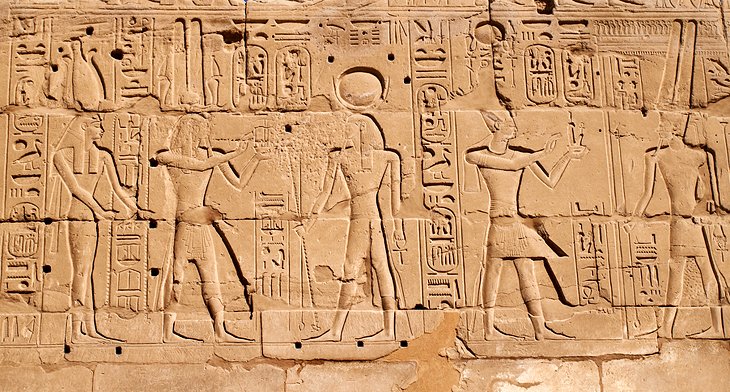
Also known as the White Chapel, the Kiosk of Sesostris I, just to the north of the Great Temple of Amun, is one of the oldest structures in the whole temple complex and dates from Ancient Egypt's Middle Kingdom era.
Built of fine limestone, it was erected to commemorate Pharaoh Sesostris I's jubilee. Sesostris is only one of the common anglicizations of this pharaoh's name, and you'll also see this building referred to as the kiosk or white chapel of Senusret I.
The kiosk stands on a substructure and is approached by ramps on the east and west sides. The roof is borne on 24 pillars, which, like the outer walls, are covered with reliefs of excellent quality.
In the interior is a base for the sacred barque of Amun.
Temple of Ptah
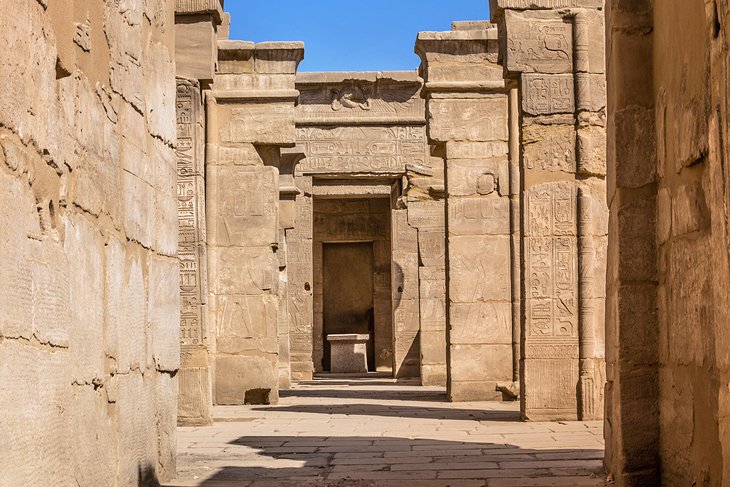
The Temple of Ptah, tutelary god of Memphis, was built by Tuthmosis III and enlarged and restored by the Kushite Pharaoh Shabaka and later, by some of the Ptolemies. It sits snug against the Karnak complex's northern boundary wall.
The temple is approached from the west through five successive gateways. Beyond this is a passage formed by four columns with rich foliage capitals, linked by screens. At the end of the passage is a small Pylon with the names of Tuthmosis III (restored in the Ptolemaic period) on the doorway.
The entrance passage leads into a Court, on the rear side of which is a portico with two 16-sided columns. In the portico are two altar bases of red granite with dedications by Amenemhet I and Tuthmosis III. In the walls are six niches, and a staircase leads to an upper story.
In the center of the court, a door leads into the temple's sanctuary. Here, on the doorway, you can see restored reliefs dating from the reign of Tuthmosis III, while the Sanctuary preserves original reliefs of that period.
In the Sanctuary is the cult image of Ptah (now headless), which is lit, with magical effect, by an aperture in the roof. To the right is a room containing a statue of the lion-headed goddess Sekhmet, and to the left, another room with reliefs of Tuthmosis III.
Northern Temple Precinct
From the small Temple of Ptah, a gateway in the north enclosure wall gives access to the Northern Temple Precinct surrounded by a brick wall.
The north gateway of the temple precinct was built by Pharaoh Ptolemy III Euergetes. In the enclosure wall to the south of the temple is a gateway with the name of Nectanebo II and the remains of a list of the people he subdued.
Temple of Montu
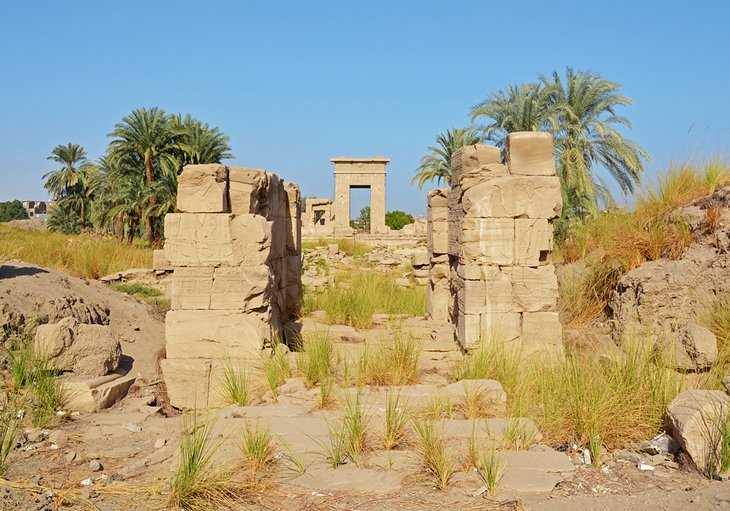
Within the Northern Temple Precinct is the Temple of Montu, the war god, an old local god of Thebes.
It was built by Amenophis III (18th Dynasty), but was several times altered and enlarged down to the period of the Ptolemies.
The temple is so badly ruined that it is difficult to even make out the ground plan, but the older fragments of sculpture and architectural elements display a high standard of artistic skill.
Outside the north entrance stood two obelisks of red granite, of which the bases and some fragments still remain.
East from the Main Temple of Amun
Temple of Ramses II
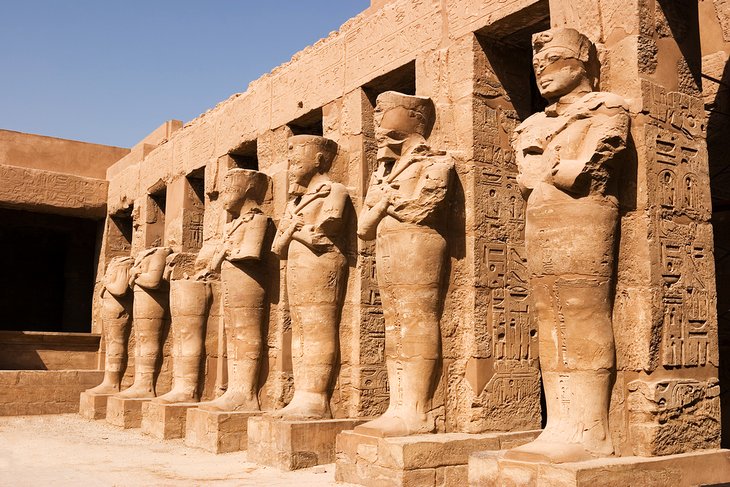
Just after the eastern exit of the Great Temple of Amun, beyond an unexcavated mound of rubble, is the badly ruined Temple of Ramses II, built on the same axis as the principal temple, which cuts across an older brick enclosure wall.
The entrance doorway, on the east side, leads into a hall with two Osiris pillars, behind which is a narrow Hypostyle Hall. In front of the doorway there was originally a hall dating from the reign of Taharqa, with 20 columns linked by screens.
North of these structures are the remains of another Temple of Ramses II, perhaps dedicated to the cult of Pharaoh Mentuhotep III (11th Dynasty), which was restored in the time of Ptolemies.
South of these remains, to the east of the Sacred Lake, are the remains of a brick building dating from before the Middle Kingdom.
Temple of Osiris
Built against the eastern enclosure wall is a small Temple of Osiris erected by Osorkon III (22nd Dynasty); his son and co-ruler Takelothis III; and his daughter, Shepenwepet.
The front chamber was added by Amenirdis, sister of Kushite Pharaoh Shabaka (25th Dynasty) and mother-in-law of Psammetichus I. In the vicinity are a number of small chapels of the 26th Dynasty.
East Gate
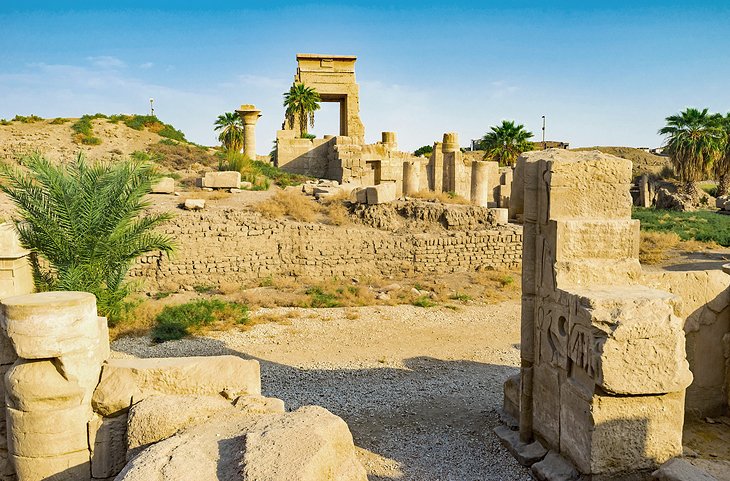
Beyond the Temple of Ramses II, to the east, is the well-preserved East Gate (now closed) in the brick enclosure wall, which surrounded the whole temple precinct.
Built by Nectanebo I, it stands 19 meters high.
South from the Main Temple of Amun
Sacred Lake
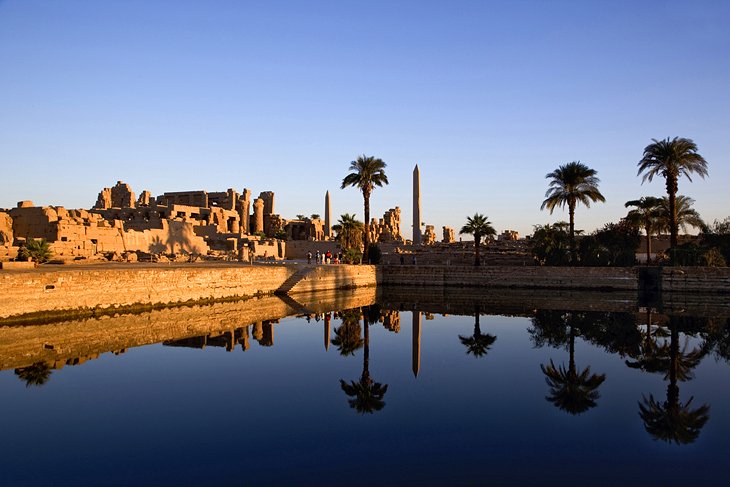
To the south of Ramses II's enclosure wall around the Temple of Amun lies the Sacred Lake.
In Arabic, it is known as Birket el-Mallaha ("Lake of the Salt Pan"), as the water of the lake is slightly saline.
The lake was probably used for ritual ablutions by the temple's priests.
The walls encircling the lake are well preserved on the west, south, and north sides, from which steps lead down to the water. On the north side is a structure built by Tuthmosis III.
Near the northwest corner are the ruins of a building erected by Kushite Pharaoh Taharqa, and on the edge of the lake is a large granite scarab dedicated by Amenophis III to the sun god Atum-Khepri, who was represented in the form of a scarab.
Temple of Khonsu
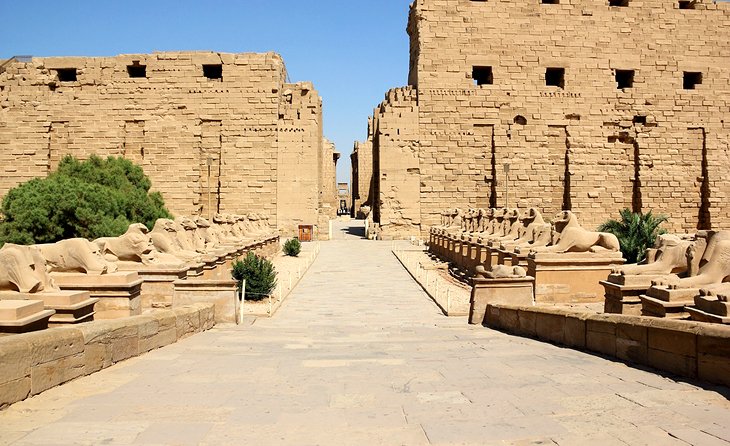
A short avenue of sphinxes, set up by Ramses XI, the last of the Ramessids, leads to the Temple of Khonsu, dedicated to the Theban moon god (son of Amun and Mut), a characteristic example of the architecture of the New Kingdom.
The temple was built by Ramses III, but the reliefs, apart from those in the innermost chambers, which were completed during his reign, were executed during the reigns of his successors Ramses IV and XII and the priest king Herihor, who also built the forecourt.
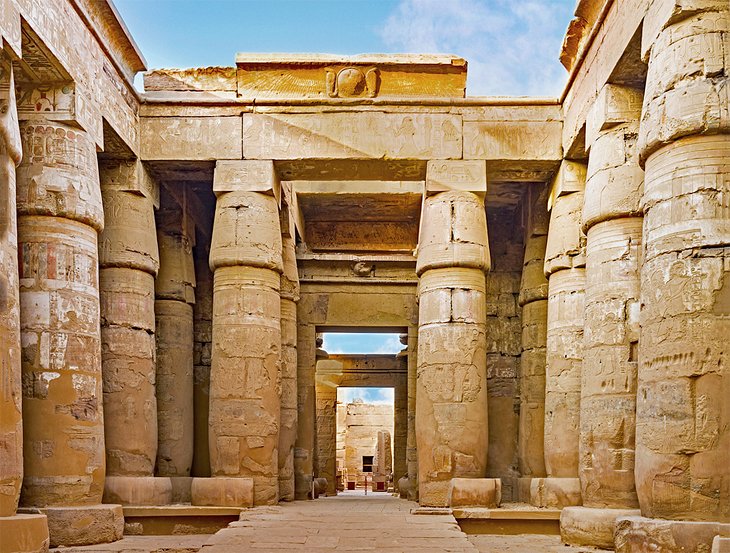
The central doorway, with reliefs of Alexander II, leads into the Forecourt, flanked on the right and left by a double row of papyrus columns with closed capitals.
The temple is entered by a large Pylon, 32 meters long, 10 meters deep, and 18 meters high. Like the facades of other temples, it has four vertical grooves, with corresponding apertures in the masonry, for the fixing of flagstaffs.
The reliefs on the towers depict a High Priest of the 21st Dynasty and his wife making offerings to various gods. In front of each tower stood a portico with a wooden roof; the bases of the columns are still in situ.
On the far side of the forecourt, a ramp leads up to the Vestibule with 12 columns. Beyond this is a transverse Hypostyle Hall with eight papyrus columns; the four columns flanking the central aisle have open capitals, while the columns between the lateral aisles (which are 1.5 meters lower than the central aisle) have closed capitals.
On the walls and columns, Ramses XII and Herihor, High Priest of Amun, are depicted sacrificing to various gods.
The door in the middle of the rear wall leads into a larger hall, where the Sanctuary was designed to house the god's sacred boat.
The reliefs on the outer walls depict the pharaoh (Ramses IV or XII) in the presence of various gods. Built into the walls are blocks bearing reliefs and cartouches of Tuthmosis III.
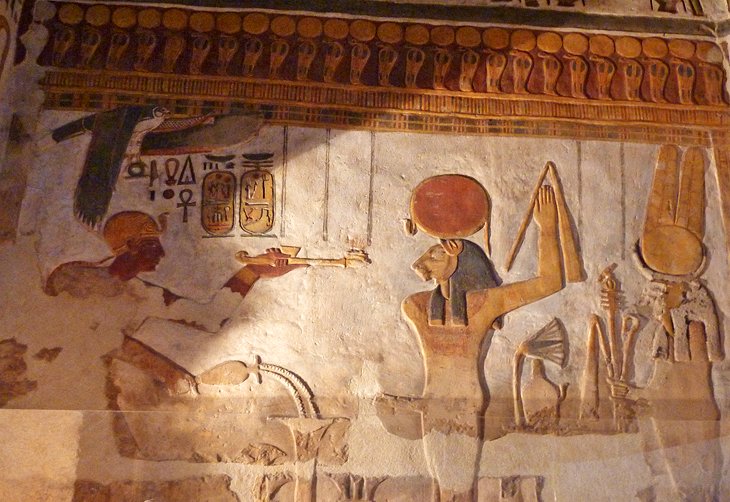
Don't Miss: On each side of the Sanctuary are dark chambers with reliefs of Ramses IV, and to its rear, a doorway built by one of the Ptolemies gives access to a small chamber with four 16-sided columns and the reliefs, which show Ramses IV and (to the right and left of the entrance) the Emperor Augustus in the presence of the Theban gods.
Adjoining are seven small chapels with reliefs of Ramses III and his successor. The colors are particularly well preserved in the reliefs in the two chapels on the right-hand (east) side.
On the long north wall of the rear chapel, the pharaoh, accompanied by Hathor, offers flowers to the falcon-headed Month of Thebes and to the goddess "Sun of the Two Lands, Eye of Re," who is seated in a chapel.
On the west wall, he offers incense and water to a lion-headed, ithyphallic god and to Khons. In another chapel at the northeast corner of the temple, which is dedicated to the cult of Osiris, is a relief of the dead Osiris, with Isis and Nephthys mourning at his bier.
Temple of Osiris and Opet
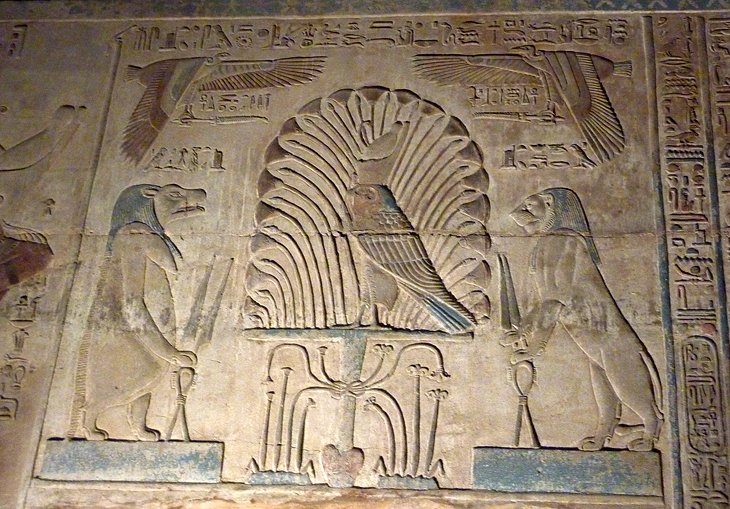
Adjoining the southwest side of the Temple of Khonsu is a small Temple of Osiris and Opet (the hippopotamus goddess of childbirth and mother of Osiris) built by Euergetes II.
It stands on a three-meter-high base topped by a cavetto cornice, with the main entrance on the west side. On the uprights of the doorway, the king is depicted before Osiris and other deities.
The entrance, on the west side, leads into a rectangular hall, with a well-preserved ceiling supported on two columns with floral capitals and Hathor heads. High up on the south wall are lattice windows. To the right are three side chambers with crypts; the door on the left is walled up.
Beyond this is a second hall, with mural reliefs depicting the king in the presence of various deities.
Off this hall open two side chambers. In the left-hand one is a relief of the dead Osiris, with Isis and Nephthys standing by the bier, while the one on the right is dedicated to the birth of Horus.
The relief above the door of this room shows Isis suckling Horus, surrounded by gods; to the left the king brings milk, to the right, a length of cloth. On the lintel, Harsomtus is depicted in a swamp in the guise of a falcon wearing the double crown, protected by the hippopotamus goddess Opet and a lion goddess.
A door with a figure of the goddess Opet leads into the Sanctuary, with a niche, which originally held a statue of the goddess.
The reliefs in the niche show the pharaoh in the presence of Opet, who is represented on the right as a post with a Hathor head and on the left as a hippopotamus.
In the east wall of the temple is a small Chapel of Osiris, built by Ptolemy XIII, with its own entrance on the east side. To this temple belongs the shaft, which stands in the Sanctuary of the Temple of Opet and may have contained a relic of Osiris.
Southern Temple Precinct
From the 10th Pylon, an avenue of sphinxes dating from the reign of Horemheb (in which stones from Amenophis IV's temple, formerly built into the 10th Pylon, are now deposited) leads to a gateway built by Ptolemy II Philadelphus, with reliefs and long inscriptions, in the enclosure wall of the Southern Temple Precinct.
To the east of the avenue is a Chapel of Osiris-Ptah built by the Kushite Pharaohs, Tanutamun and Taharqa (25th Dynasty), with well-preserved painted mural reliefs.
The gateway leads into an unexcavated area in which large figures of rams, sphinxes, and a large alabaster stela of Amenophis III (usurped by Ramses II) lie around.
Temple of Mut
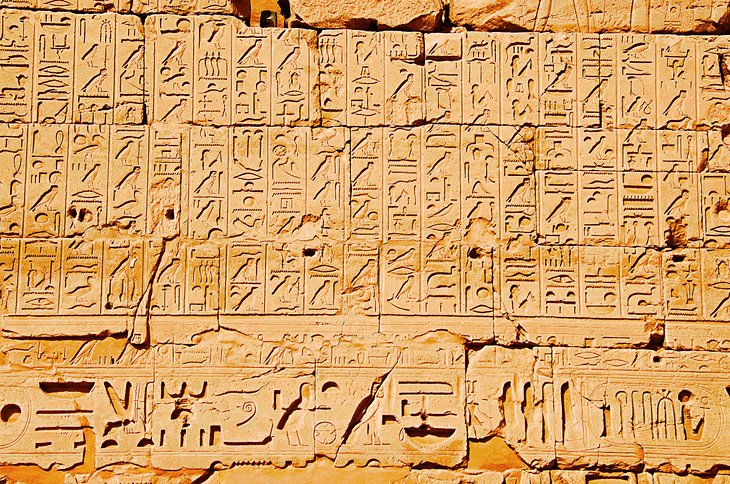
Immediately south of the gateway out of the main temple enclosure is the Temple of Mut, also built by Amenophis III. In front of the entrance are pillars bearing figures of the god Bes.
The doorway itself has long inscriptions of the Ptolemaic period (hymns to the goddess Mut) and an inscription of Ramses III, who restored the temple.
The doorway leads into a large court crossed by a processional way flanked by columns, which led to the temple proper.
In the court are numerous seated figures of the goddess Sekhmet dedicated by Amenophis III; on some, his name has been replaced by that of Sheshonq I.
To the left, lying on the ground, are two gigantic figures of Amenophis III (usurped by Ramses II), which formerly stood before the entrance to the temple.
Beyond this is a Second Court, with colonnades along the sides. Fragments of the Hathor capitals of the pillars and of statues of Sekhmet lie around.
To the right of the entrance is a large statue of Sekhmet, to the left, a black granite statue of Amenophis III.
On the far side of the court are a hall with papyrus cluster columns, the Sanctuary, and other rooms, all in a ruinous state.
Tips and Tactics: How to Make the Most of Your Visit to the Temples of Karnak
Sound & Light Show:
- Karnak's Sound & Light Show plays two shows nightly with the first show always in English and the second show in either German, Italian, French, or Spanish depending on the day. As well as booking tickets independently, you can also opt to take a tour.
Timing to Beat the Crowds:
- Karnak opens at 6am, and the earlier you can get here to beat the heat and the tour bus crowds, the better. Whatever you do, avoid 10am to 3pm when the majority of tour buses from the Red Sea disgorge huge groups into the temples.
Timing for Photographers:
- Try to get here for 5pm to see the stonework glow in the late afternoon sun and the grand shadows of statuary cast atmospherically against the walls.
Getting Here
- Walk along the Corniche: If it's not too hot, it's easy enough to walk from downtown Luxor along the Corniche (Nile-side road) to Karnak.
- By Private Taxi: All taxi drivers in town can shuttle you to the site. There are always taxis hanging about at the entrance for when you exit.
- Horse Carriage: Luxor has a huge number of horse and carriage operators that can be used as transport within town. All of them can take you to Karnak.
More Related Articles on PlanetWare.com
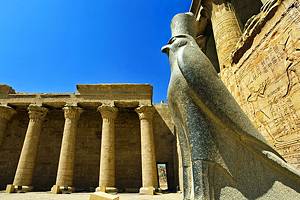
Luxor and Other Temple Complexes: Find out what else to do in Luxor with our articles on the Top Attractions in Luxor and learn more about the Valley of the Kings. Haven't had enough of temples? Check out our articles on exploring other important sites around Egypt, including Philae, Abydos, Abu Simbel, Kom Ombo and Edfu's Temple of Horus.
